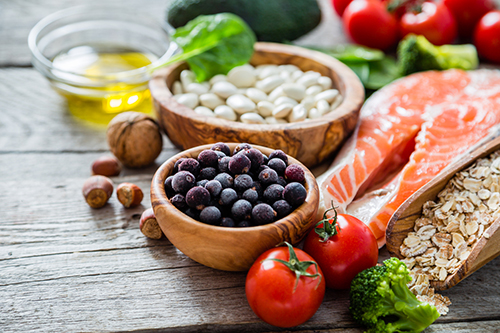A healthy diet for lowering blood pressure is much more than just limiting salt. A healthy diet full of the right nutrients can help to significantly lower blood pressure.
Eat More Healthy Minerals
Increasing calcium, magnesium, and potassium consumption can have a much more profound impact on lowering blood pressure than simply limiting sodium. Calcium, magnesium, and potassium are found in a wide range of healthy and delicious foods that are easy to incorporate into a healthy diet no matter what other health conditions you may be working around.
- Aim to eat at least 1,250 mg of calcium a day.
- Aim to eat at least 500 mg of magnesium a day.
- Aim to eat 4,700 mg potassium a day. If you have advanced chronic kidney disease, aim for 1,500-2,700 mg per day depending on your blood potassium levels.

Healthy Mineral Food Guide
Dairy
Dairy products are the best known of the calcium rich foods, but they are also a fairly good source of magnesium and potassium as well. One cup of milk has 275 mg calcium, 25 mg magnesium, and 320 mg potassium. It’s easy to incorporate a variety of delicious dairy products into the diet such as milk, cheese, yogurt, and kefir. Full-fat varieties have more calories, but can be a healthy option if energy intake is balanced.
Seafood with Bones
Seafood with edible bones is a fantastic source of calcium for those who don’t tolerate dairy products well. Canned salmon with bones is an inexpensive option – 3 oz has 240 mg of calcium. Anchovies and sardines are also good options, just look for products with the least amount of sodium per serving.
Dark Leafy Greens
Leafy greens are a wonderful way to get calcium, magnesium, and potassium in the diet. Eat different varieties to get the full spectrum of good nutrition. Cooked greens are a more concentrated source of minerals since they cook down, making it easier to eat more at once.
Beans and Peas
Beans and peas are a good source of calcium, magnesium and potassium. Some varieties have more than others, so mix it up and eat different kinds each week. If using canned beans, rinse them to remove excess sodium and choose low sodium varieties.
Nuts and Seeds
Nuts and seeds are a great place to get in magnesium, and some of them have a good amount of calcium too. Sesame seeds and almonds are an especially good source of calcium.
Blackstrap Molasses
Just one tablespoon of blackstrap molasses is full of minerals – 200 mg of calcium, 100 mg magnesium, and 450 mg potassium. The flavor is strong, but if you don’t mind it’s a great way to supplement minerals without taking pills. Mix with warm water and a little honey and lemon to make a warm and tasty drink.
Homemade Chicken and Beef Stock
Simmering chicken and beef bones is a great way to make a calcium and magnesium rich stock that makes a delicious ingredient in soups, sauces, rice, and veggies. Homemade stock is also rich in protein and collagen, and is naturally low in sodium, making it a great substitution for salty store-bought broths.
Fruits and Vegetables
Some fruits and vegetables are particularly rich sources of potassium, such as potatoes, sweet potatoes, cooked greens, tomatoes, bananas, oranges, and most tropical fruits. Most all fruits and veggies have some amount of potassium, magnesium, and calcium, so eat a wide variety to get plenty each day.
Whole Grains
Magnesium can be found in products made with whole wheat flour, though it is not as easily absorbed for use in the body as from other sources. White flour products have had most of the magnesium stripped out through processing, so they are not very good source of magnesium.
Sea Salt or Himalayan Pink Salt
Although Sea Salt and Himalayan Pink Salt still have the same amount of sodium as regular salt, these kinds of salt have the added benefit of containing minerals other than sodium, especially calcium, magnesium, and potassium. Use these for cooking at home to get a little added dose of minerals each day.
